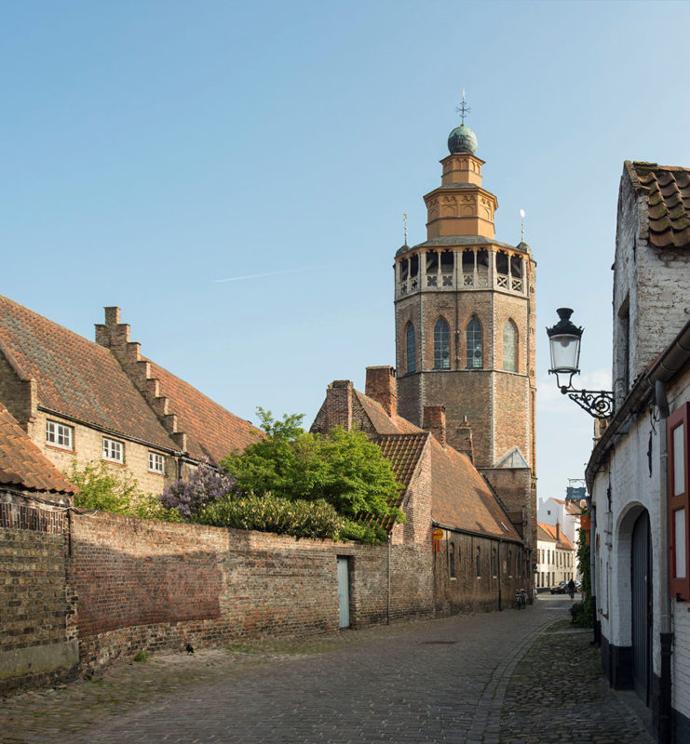ADORNES ESTATE
Located in Bruges, the Adornes Estate is a historical treasure founded in the 15th century by the Adorno family from Genoa.
Today, it remains in the hands of Count and Countess Maximilien de Limburg Stirum, direct descendants of its founders.
PRESENTATION
This private estate consists of the Jerusalem Chapel, almshouses and a mansion with a vast adjacent garden.
Consecrated in 1429, the chapel was inspired by the Church of the Holy Sepulchre in Jerusalem and is renowned for its distinctive architecture and unique decorations.
Inside, visitors can admire remarkable paintings, sacred relics, and a crypt, as well as the impressive tomb of Anselm Adornes and his wife.
An interactive museum, located within the former almshouses, vividly recounts the fascinating history of the Adornes family, with a special focus on Anselm Adornes—an influential merchant, diplomat, and knight. His travels, including a pilgrimage to the Holy Land, highlight his significant role in the commercial and political landscape of his time.
HOF BLADELIN
Nestled in the heart of Bruges, Hof Bladelin is a magnificent medieval city palace with a rich history shaped by art, faith, and trade.
Since 1964, it has been under the care of the Congregation of the Sisters of Our Lady of the Seven Sorrows, Ruiselede, who are dedicated to preserving this remarkable heritage.
PRESENTATION
Stepping into the enclosed garden of Hof Bladelin is like travelling back to the Burgundian era of Bruges. Originally built for Pierre Bladelin, Treasurer of the Order of the Golden Fleece, the residence was later expanded by Piero de Medici, a member of the renowned Florentine banking dynasty, and further extended in the 16th century by the influential Egmont family.
Over the centuries, Hof Bladelin served as an aristocratic residence and, between 1632 and 1669, housed a Carmelite convent.
Around 1830, Abbot Léon de Foere established a religious institute for the poor, founded a lace school, and commissioned a neoclassical chapel. He also adorned the audience hall with monumental frescoes—faithful reproductions of Raphael’s Vatican murals.
LOPPEM CASTLE
Loppem Castle, near Bruges, is a stunning neo-Gothic masterpiece from the mid-19th century. Set within a vast park with ancient trees, ponds, and a labyrinth, it offers a unique historical and architectural experience.
In 1951, Baron Jean van Caloen established a foundation to preserve the castle, its furnishings, park, and outbuildings while promoting its rich art collections.
PRESENTATION
Designed as a complete work of art, the castle seamlessly blends exterior and interior elements. The English architect Edward Welby Pugin created the furniture, while Jean-Baptiste Bethune designed the interiors. Skilled local craftsmen crafted the stained glass, chandeliers, staircases, and fireplaces.
The ground floor features elegant reception rooms that reflect 19th-century grandeur, while the upper floor houses the family chapel and royal chambers. These rooms recall the castle’s prestigious past, including the stay of King Albert I and Queen Elisabeth in 1918, shortly after the First World War. The ground floor features elegant reception rooms that reflect 19th-century grandeur, while the upper floor houses the family chapel and royal chambers.
The castle displays medieval, Asian, and African art collections assembled by Jean and Roland van Caloen.
These rooms recall the castle’s prestigious past, including the stay of King Albert I and Queen Elisabeth in 1918, shortly after the First World War.
WYNENDAELE CASTLE
Wynendaele Castle, located in Torhout, is a historic residence with a rich past. Originally a medieval fortress, it was largely restored to its former splendour in the 19th century. With over 1,000 years of history, this architectural gem remains the property of the Matthieu de Wynendaele family, preserving its heritage and timeless character.
PRESENTATION
First mentioned in 1127, the castle is believed to have been built by Robert I of Flanders as a residence for the Counts of Flanders. During the 13th century, under Guy of Dampierre, it played an important diplomatic role, hosting negotiations and alliances.
In the 15th century, the castle was taken over by John the Fearless, Duke of Burgundy, and later inhabited by the House of Cleves, Lords of Ravenstein. In 1482, tragedy struck in the surrounding forest when Duchess Mary of Burgundy suffered a fatal accident during a hunting expedition. Over the centuries, the castle endured many hardships. In 1795, it was ransacked by French troops, leaving it in ruins.
During the 19th century, the castle underwent significant restoration under the guidance of Brussels banker Josse Pierre Matthieu. He preserved several original features, including parts of the north wing dating back to 1302.
In 1940, the castle once again became the setting for a historic event: the fateful meeting between King Leopold III and his ministers at the onset of the Second World War.














